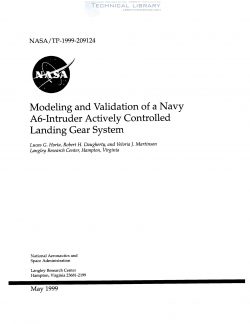NASA-TP-1999-209124
- Version
- 90 Downloads
- 1.32 MB File Size
- 1 File Count
- July 6, 2017 Create Date
- July 6, 2017 Last Updated
Modeling and Validation of a Navy A6-Intruder Actively Controlled Landing Gear System

Market analysis of future commercial air travel has identified a significant trans-Pacific market for
supersonic transports. Fuselage and wing design of these transports is governed primarily by aerody-
namics and associated structural loads. Placement and sizing of the landing gear occur at a later stage in
the design process, with design constraints such as braking requirements, turning radius for ground han—
dling, ground clearance during rotation, and weight distribution as the main criteria (ref. 1).
Long, slender, flexible fuselage configurations, especially those with a long overhang from the nose
gear to the cockpit, are susceptible to ground-induced vibration problems, particularly those produced
by operating over long-period, low—amplitude elevation disturbances on runways. Although in-flight
vibrations are also a concern, the work discussed herein will address the mitigation of vibrations trans-
mitted from the ground to the aircraft fuselage. The mitigation is accomplished by embedding a control
system directly into the landing gear.
This paper presents results from an activity at Langley Research Center that investigated three
aspects of actively controlled landing gear: analytical modeling, control system design, and experimen-
tal validation. This work attempts to improve the fidelity of analytical models so that they can be used
for control design and experimental demonstration of various control philosophies. Development of an
experimental facility that permits realistic concepts that can be transferred to commercial applications is
also a goal.
Development of landing gear analysis dates back to the late 1950’s (ref. 2). Work has included
numerical simulation techniques and experimental measurements to validate the various computer pro—
grams. A significant volume of the work available in the literature deals with military aircraft requiring
accurate prediction of taxi loads over repaired, bomb-damaged runways (refs. 3—6). A computer simula-
tion program named HAVE BOUNCE (ref. 6) was developed to simulate the dynamic response of mili-
tary aircraft over bomb-damaged runways. To validate the computer code, model validation was
performed at the Aircraft Ground—Induced Loads Excitation (AGILE) (ref. 7) test facility at Wright-
Patterson Air Force Base. Recently, attention has focused on ride quality during taxi, takeoff, and land-
ing (refs. 8 and 9). A simulation program developed by Stirling Dynamics (refs. 8 and 9) is a good
example of new simulation capabilities. This particular computer simulation program has been vali-
dated with data from commercial transports in Europe.
| File | Action |
|---|---|
| NASA-TP-1999-209124 Modeling and Validation of a Navy A6-Intruder Actively Controlled Landing Gear System.pdf | Download |
Comment On This Post